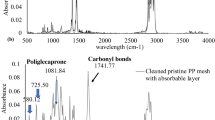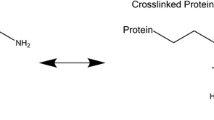Abstract
During its tenure in vivo, synthetic mesh materials are exposed to foreign body responses, which can alter physicochemical properties of the material. Three different synthetic meshes comprised of polypropylene, expanded polytetrafluoroethylene (ePTFE), and polyethylene terephthalate (PET) materials were explanted from a single patient providing an opportunity to compare physicochemical changes between three different mesh materials in the same host. Results from infrared spectroscopy demonstrated significant oxidation in polypropylene mesh while ePTFE and PET showed slight chemical changes that may be caused by adherent scar tissue. Differential scanning calorimetry results showed a significant decrease in the heat of enthalpy and melt temperature in the polypropylene mesh while the ePTFE and PET showed little change. The presence of giant cells and plasma cells surrounding the ePTFE and PET were indicative of an active foreign body response. Scanning electron micrographs and photo micrographs displayed tissue entrapment and distortion of all three mesh materials.








Similar content being viewed by others
References
Everhart JE, editors. Digestive diseases in the united states: epidemiology and impact. Washington, DC: U.S. Government Printing Office 2004. National Institute of Health Publication No. 94-1447.
Flegal KM, Carroll M, Ogden C, Curtin L. Prevalence and trends in obesity among US adults: 1999–2008. JAMA. 2010;303(3):235–1.
Iqbal Y. Controversies in inguinal hernia repair. Outpatient Surg Mag. 2000;1(8). http://www.outpatientsurgery.net/issues/2000/08/controversies-in-inguinal-hernia-repair.
Neumayer l, Giobbie-Hurder A, Jonasson O, Fitzgibbons R, Dunlop D, Gibbs J, Reda D, Henderson W. Open mesh versus laparoscopic mesh repair of inguinal hernia. N Engl J Med. 2004;350:1819–7.
Cozad M., Ramshaw BR, Grant DN, Bachman SL, Grant DA, Grant SA. Materials characterization of explanted polypropylene, polyethylene terephthalate, and expanded polytetrafluoroethylene composites: spectral and thermal analysis. J Biomed Mater Res B. 2010;49B:455–2.
Costello CR, Bachman SL, Ramshaw BR, Grant SA. Materials characterization of explanted heavyweight polypropylene hernia meshes. J Biomed Mater Res B. 2007;83B:44–9.
Deeken CR, Abdo MS, Frisella MM, Matthews BD. Physicomechanical evaluation of polypropylene, polyester, and polytetrafluoroethylene meshes for inguinal hernia repair. J Am Coll Surg. 2011;212(1):68–79.
Laurikainen EH, Valpas A, Kivela A, Kalliola T, Rinne K, Takala T, Nilsson CG. Retropubic compared with transobturator tape placement in treatment of urinary incontinence: a randomized controlled trial. Obstet Gynecol. 2007;109:4–11.
Rehder P, Glodny B, Richler R, Mitterberger MJ. Massive retropubic hematoma after minimal invasive mid-urethral sling procedure in a patient with a corona mortis. Eur Urol. 2008;53:288–308.
U.S. Food and Drug Administration. Urogynecologic Surgical Mesh Implants. http://www.fda.gov/MedicalDevices/ProductsandMedicalProcedures/ImplantsandProsthetics/UroGynSurgicalMesh/default.htm. Accessed 1 April 2012.
Costello CR, Bachman SL, Cleveland DS, Loy TS, Grant SA, Ramshaw BR. Characterization of heavyweight and lightweight polypropylene prosthetic mesh explants from a single patient. Surg Innov. 2007;14:168–76.
Mihaly J, Sterkel S, Ortner H, Kocsis L, Hajba L, Furdyga E, Mink J. FTIR and FT-Raman spectroscopic study on polymer based high pressure digestion vessels. Croat Chem Acta. 2006;79:497–501.
Ratner B, Hoffman AS, Schoen FJ, Lemons JE, editors. Biomaterials science. London: Elsevier Academic Press; 1996. p. 243–4.
Bracco P, Brunella V, Trossarelli L, Coda A, Botto-Micca F. Comparison of polypropylene and polyethylene terephthalate (Dacron) meshes for abdominal wall hernia repair: a chemical and morphological study. Hernia. 2005;9:51–5.
Fayolle B, Audouin L, Verdu J. Oxidation induced embrittlement in polypropylene—a tensile testing study. Polym Degrad Stab. 2000;70:333–40.
He P, Xiao Y, Zhang P, Xing C, Zhu N, Zhu X. Thermal degradation of syndiotactic polypropylene and the influence of stereoregularity on the thermal degradation behavior by in situ FTIR spectroscopy. Polym Degrad Stab. 2005;88:473–9.
Lappan U, Geibler U, Lunkwitz K. Electron beam irradiation of polytetrafluoroethylene in vacuum at elevated temperature: an infrared spectroscopic study. J Appl Polym Sci. 1999;74:1571–6.
Pugmire DL, Wetteland CJ, Duncan WS, Lakis RE, Schwartz DS. Cross-linking of polytetrafluoroethylene during room-temperature irradiation. Polym Degrad Stab. 2009;94:1533–41.
Clave A, Yahi H, Hammou JC, Montanari S, Gounon P, Clave H. Polypropylene as a reinforcement in pelvic surgery is not inert: comparative analysis of 100 explants. Int Urogynecol J. 2010;21:261–70.
Waler C, Sigbritt K. Assessment of thermal and thermo-oxidative stability of multi-extruded recycled PP, HDPE and a blend thereof. Polym Degrad Stab. 2002;78:385–91.
Burger JWA, Halm JA, Wijsmuller AR, ten Raa S, Jeekel J. Evaluation of new prosthetic meshes for ventral hernia repair. Surg Endosc Other Interv Tech. 2006;20(8):1320–5.
Riepe G, Loos J, Imig H, Schroder A, Schneider E, Petermann J, Rogge A, Ludwig M, Schenke A, Nassutt R, Chakfe N, Morlock M. Long-term in vivo alterations of polyester vascular grafts in humans. Eur J Vasc Endovasc Surg. 1997;13:540–8.
Elison BJ, Frisella MM, Matthews BD, Deeken CR. Effect of repetitive loading on the mechanical properties of synthetic hernia repair materials. J Am Coll Surg. 2011;213(3):430–5.
Hernández-Gascón B, Peña E, Melero H, Pascual G, Doblaré M, Ginebra MP, Bellón JM, Calvo B. Mechanical behavior of synthetic surgical meshes: finite element simulation of the herniated abdominal wall. Acta Biomater. 2011;7:3905–13.
Acknowledgments
This research was supported in part by the University of Missouri Life Sciences Predoctoral Fellowship, the University of Missouri F21C, and BICAM (Biomaterials Innovation, Characterization, and Analysis of Missouri) laboratory at the University of Missouri.
Author information
Authors and Affiliations
Corresponding author
Rights and permissions
About this article
Cite this article
Wood, A.J., Cozad, M.J., Grant, D.A. et al. Materials characterization and histological analysis of explanted polypropylene, PTFE, and PET hernia meshes from an individual patient. J Mater Sci: Mater Med 24, 1113–1122 (2013). https://doi.org/10.1007/s10856-013-4872-y
Received:
Accepted:
Published:
Issue Date:
DOI: https://doi.org/10.1007/s10856-013-4872-y




